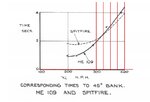GregP
Major
Nobody COULD achieve full deflection at high speeds, though. That's the point. Numerous pilot reports make that pretty clear.
What we need is a roll rate comparison "as tested," not "as calculated."
What we need is a roll rate comparison "as tested," not "as calculated."

